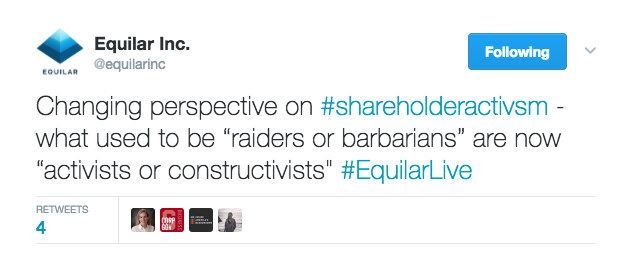In the past few years, shareholder activism has evolved from a rare and unlucky occurrence to a commonplace lens through which companies are assessed. Board members are warming up to these corporate watchdogs, in part because today's activist environment leaves them no choice. Yet, there seems to be a growing segment of corporate directors who are recognizing the value of activist feedback'particularly for the introspective exercises they impose on the board.
According to PwC's Annual Corporate Directors Survey, 80% of directors indicate that shareholder activism has compelled companies to more effectively evaluate strategy, execution, and capital allocation. With equal fervor, activists are now targeting small- and mid-cap companies, and the threat of a proxy battle has left boards no choice but to devote more time and attention to the areas of activist focus.
To outline the 'danger zones' for boards, Greg Taxin (Managing Director at Spotlight Advisors) recently joined us on Inside America's Boardrooms. Taxin, who's perhaps best-known for co-founding Glass Lewis, has long devoted his career to improving the quality of information flow between investors and boards; only with the right information can investors make sound decisions about risk and capital allocation, he says.
In his episode, Taxin outlines several ways that boards can protect themselves from shareholder activists. 'The easiest thing to do is operate the business perfectly and get really lucky,' jokes Taxin. 'But of course, you can't count on that.' Taxin outlines some tenets or regular practices that can help boards avoid the attention of a shareholder activist. Let's have a look:
1. Regularly Assess Board Composition & Refresh
While we've been harping on board composition lately, it's all for good reason. Taxin reiterates that board refreshment (or lack thereof) remains a key weakness for today's boards.
It's fairly rare to find an activist with a long list of complaints [targeting] a company where the board has been self-refreshing and reflective about the skill sets, the risks, and the opportunities.
- Greg Taxin, Managing Director, Spotlight Advisors
The board must regularly assess its strategy relative to the business landscape, its competition, and its opportunities. The next essential question is: Do we have the right people in the boardroom to move us forward? To bring fresh perspectives? Taxin urges boards to align their composition with the company's opportunities.
Takeaway: Put it in the proxy.
If a tree falls in the woods, and there's no one there to hear it... does it make a sound? The same question should be asked about the board's decision-making around board composition. Has your board used a gap analysis or board evaluations to make positive changes? Has board leadership taken action to remove a director whose skills are outdated? That information must be communicated in the proxy statement. Don't miss the opportunity to tell the board's story; otherwise, activist investors will tell their own version.
- Resources:
- Why Board Composition Will Be the #1 Issue for 2017
- How to Better Communicate Peer Group Selection & Board Composition
2. Be Transparent About the Opportunities You're Taking (And Those You Aren't)
Shareholder engagement should focus on the strategic decisions your board is making. But what about those you aren't? When a board chooses to forge its own path (but fails to explain its reasoning), it can act as a magnet for activist attention.
One of the ways activists find targets is to look at the peer companies, and they say, 'Boy, everybody went to the left, and you guys went to the right...' But companies often decide to take a different path for good reason. The key is to... explain why you're choosing to do something different than everyone else, why you think it creates value or reduces risk, and why it's the right path for this company and this set of shareholders.
- Greg Taxin, Managing Director, Spotlight Advisors
Chances are your board knows why it made a strategic decision. The next step is simply to communicate that rationale with the shareholders, both through direct engagements and the proxy statement.
Takeaway: Tie it back to the strategy.
Institutional investors have been urging boards to better communicate their company's strategy. Each year, major investors like BlackRock ask boards and management to outline 'a strategic framework for long-term value creation,' including goals and benchmarks against which the board can be measured. If your board has been clear and upfront about your strategy, the rationale behind any single decision should naturally extend from the grand plan. When the board takes the road less traveled, tie it back to the strategy...before activists make their own assumptions.
3. Evaluate Your Company Like an Activist
To the extent you can, says Taxin, think objectively about your business the way that an activist would: 'Come to it with the idea that everything surely isn't perfect. Where can I find something to change?'
In his episode, Taxin outlines several key areas of activist assessment: capital structure, capital allocation, operating strategy, the management team, executive compensation alignment, etc.
Think about the piece parts of the businesses that you have. Do they really make sense under one roof? Are they big enough to support a public company as a stand-alone entity? Are there too many diverse businesses going in different directions?
- Greg Taxin, Managing Director, Spotlight Advisors
Look at each area with fresh eyes, urges Taxin. Don't fall victim to the status quo.
Takeaway: Gather the right information.
One of the biggest mistakes boards make is failing to know what an activist knows, says Taxin. For example: What do the buy-side analysts and investors really think about the management team? What do competitors say about your strengths and weaknesses? What do former executives say about the culture or the management team? Boards must gather all the information that an activist would gather; there's no other way to 'objectively' assess your company through an outsider's lens.
For more insights from Greg Taxin, don't miss our Investors Board Performance Review. Taxin is joined by BlackRock's Michelle Edkins and CalSTRS' Aeisha Mastagni in a special panel, where investors give their feedback on board performance.





